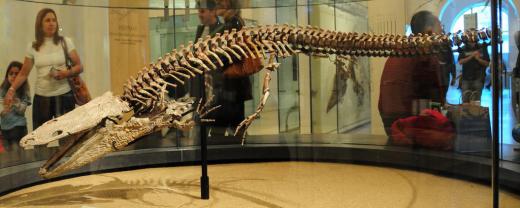What is the Triassic-Jurassic Extinction Event?
 Michael Anissimov
Michael Anissimov
The Triassic-Jurassic extinction event, which occurred worldwide about 200 million years ago, is one of five major mass extinctions throughout the past 600 million years. It is estimated that 50 percent of all species went extinct. Some paleontologists call the Triassic-Jurassic extinction the second greatest mass extinction of prehistory. It occurred in the blink of a geological eye, over no more than 10,000 years.
This extinction event wiped out about 20 percent of marine families and 30 percent of marine genera. It wiped out many therapsids, which also have been called "mammal-like reptiles," although they were neither mammals nor reptiles. Also wiped out were all large crurotarsans — non-dinosaur archosaurs, the ancestors of modern-day crocodiles, alligators and gavials — and most large amphibians, which up until that point had been the dominant terrestrial fauna.

The Triassic-Jurassic extinction came just 50 million years after the greatest extinction event in the era of animal life, the Permian-Triassic extinction of about 250 million years ago. The first mass extinction of the Mesozoic era, the Triassic-Jurassic extinction event is often seen as setting the stage for the dominance of the dinosaurs. Before the mass extinction, dinosaurs represented about 1-2 percent of the Earth's fauna, but after it, as they took over niches from extinct species, they came to represent about 50-90 percent of the fauna.
The cause of the Triassic-Jurassic extinction event is unknown. Unlike some of the other mass extinctions of the past, little evidence has coalesced around any particular interpretation. Some hypotheses include meteor impact and volcanic traps, or massive sustained eruptions over the course of a million years.
Volcanic eruptions could have triggered secondary and tertiary effects such as global warming or cooling, methane hydrate release, the reduction of oxygen levels in the oceans and more. Until more evidence emerges, scientists can't be sure. That might not occur, however. Ocean crust recycles itself about every 50 million years, so any major impact craters from meteors or comets likely has been erased.
The period of time immediately after the Triassic-Jurassic extinction was crucial, because the empty niches could have been filled either by reptiles such as the dinosaurs, or by the therapsids, which includes the ancestors of mammals. It ended up with the dinosaurs being victorious, but if the therapsids had prospered and diversified instead, mammals might have evolved more than 150 million years earlier than they actually did. It might have just been a fluke that delayed mammalian evolution until the dinosaurs themselves succumbed to another mass extinction about 135 million years later.
AS FEATURED ON:
AS FEATURED ON:











Discussion Comments
The Triassic/Jurassic extinction was the result of a rapid increase in surface gravity. This is explained in the Gravity Theory of Mass Extinction.
Basically, the Earth's surface gravity is variable over hundreds of millions of years and depends on the position of the core elements (i.e., inner/outer cores and densest part of lower mantle), which can move away from Earth-centricity, primarily when a supercontinent such as Pangea exists.
Two hundred million years ago Pangea was at its highest northern latitude, signifying the lowest surface gravity on Pangea. It rapidly reversed direction and started moving south causing a pulse of increased surface gravitation. Large animals, especially those with splayed legs, such as crurotarsans, were affected the most by the increasing gravity; they became extinct.
I don't think meteors bounce. If they hit at a sufficient angle, they can make a plasma that bounces, but the meteors themselves will bury themselves/disintegrate upon impact.
crazy article, but it really helped. thanks.
The extinction event 200 million years ago, may have been caused by a meteor, with a low angle trajectory, which bounced in the Gulf of St. Lawrence rolled on or bounced over the Appalachian Mountain area hitting again around the Tuscaloosa/Birmingham, Alabama area and bouncing into Mexico where it impacted near Ebano Mexico causing a fracture in the land mass. A second option would be three large comet impacts at these locations. This fracture grew over 200MY causing the formation of the Yucatan Peninsula and the Gulf of Mexico. The other half of the crater in Mexico is centered near Catemaco Mexico. In the US, the impact cracked the bedrock and created a slip fault along the St. Lawrence Seaway (River) through Lake Ontario and Lake Erie to the Ohio River down the Mississippi and ending in the Gulf of Mexico.
The New Madrid Fault is the current catch point for the east coast portion sliding against the mid-west portion of the North American Plate. You can see how the east coast portion has moved north-east at the Gulf of St. Lawrence and at New Orleans. This fault also created the Mississippi Embayment, separated Africa, Europe and Greenland from the US and created the northern portion of the Mid-Atlantic Ridge. The Triassic/Jurassic extinction event occurred at this time as well as the formation of the Central Atlantic Magmatic Province found along the east coast of the US. The Petrified Forest in Arizona also formed around this time. An ocean wave or just the impact blast could have knocked down and buried the trees. The sound would have been incredible.
All three crater sites line up if you take into account approximately 100 miles of north-east movement between the east coast and mid-west sections.
Ophiolites (possibly associated with the Central Atlantic Magmatic Province and the northern portion of the Mid-Atlantic Ridge) are indicated in the book “Mantle Plumes: Their Identification Through Time” along the east coast Appalachian Range.
Other crater sites are possible north east of the Gulf of St. Lawrence in Greenland or Europe.
Curtis Thompson
Plano, Texas
Post your comments